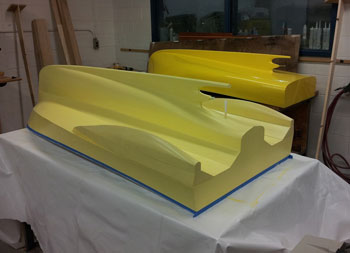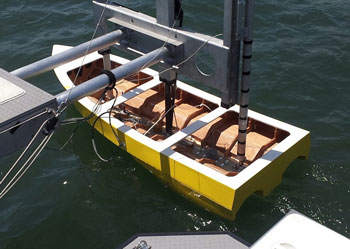Lobster Boat Trimaran Sea Tested
Fishermen’s Voice Staff

Trimaran hull in foreground and conventional lobster boat hull near completion at Maine Maritime Academy. Students built the hulls during the 2012-13 school year. The trimaran hull is expected to reduce fuel use by 25%+ while retaining the above the waterline appearance of the traditional lobsterboat. Doug Read Photo
A trimaran hull designed at Maine Maritime Academy was tested in the waters off San Diego, California in late May. Naval architect, MMA teacher and the hull’s designer, Doug Read said the trials went well. The project was developed and funded through the Penobscot East Resource Center in Stonington, Maine.
The 7-foot model being tested was built by students at MMA in the 2012-13 school year. It is fully instrumented to gather a wide range of data on the hull’s behavior in varied sea conditions. The data will be used to predict the performance of a 38' vessel.
The testing is being done at the Mship Company in San Diego where tests can be done in real waves. More typically this testing is done with tows a in test tank where real conditions are simulated. Mship has a 24' vessel designed to carry a test model vessels off the side while attached to a double yardarm like apparatus. Another 7' conventional lobster boat test model hull was carried off the opposite side of the testing vessel. Data from both fully instrumented vessels was collected in on board computers.
Several load sensors are attached to points around the hull. “Test results were what we expected regarding drag and handling waves,” said Read.
Speed tests were taken up to 30 knots. The final 38' vessel is being designed to operate at a 20 knot maximum. Read said their research showed lobstermen most often operated at top speeds in the 15 to 20 knot range.
The vessel floats on three narrow hulls. The center hull is the largest running the length of the vessel. The two on either side are much narrower, shorter and located toward the aft end. They are more like stabilizers and produce very little drag. Between the three hulls are tunnels where those parts of the hull are out of the water.
The trimaran lobster boat is expected to go through the water about 25%+ more efficiently than the conventional monohull, with an expected 25%+ less fuel consumption. At speeds above 22 knots monohulls plane and are more efficient than the trimaran.

The Maine Maritime Academy trimaran lobster boat hull being tested in San Diego Bay, California. The 7-foot model is fully instrumented for collecting performance data in real sea conditions. The model is attached to a 24' sea testing vessel. Doug Read Photo
The next phase of the project is a full size 38' model. The plan calls for using a John Deere 200HP inline 6. The narrow engine will fit well in the narrow center hull.
Fuel costs are expected to continue to rise taking an ever larger part of lobstermen’s earnings. Maine boat builders are known to be very good at what they do and have highly developed the boats they build. Knowing that Read said improvement therefore could only be found in a radical change.
At the same time there is tradition to consider. Perhaps more important is the preservation of a work platform that is know to be functional and reliable. Above the waterline the final vessel will look like a conventional lobster boat with all the work space, wheelhouse and carrying capacity of a boat that size.
